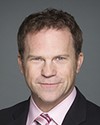The interviews we conducted were to understand the environment in which these people have to work. On that basis, we were able to sort of synthesize some of the most important ergonomic aspects of this, the ergonomics as a man-machine interface, really, that we're looking at, the human aspects.
What we have concluded, and it's very well shown in the report, is that it is very important to take into account exactly and to create the environment in which these people can work in safety and essentially without putting their health at risk.



